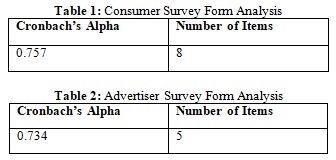What’s Real and What’s Fake : A Study on the use of Deep Fake Technology in Advertising
DOI:
https://doi.org/10.54741/mjar.3.1.3Keywords:
advertising, deepfake technology, experiential marketing, hyper-personalized advertisingAbstract
According to the research "World Advertising Market: Industry Trends, Share, Size, Growth, Potential and Forecast 2021-2026" by IMARC group, the global advertising industry is anticipated to reach US$ 875 billion by the year 2026, with a predicted CAGR of 5.2% between 2021-2026. The range of digital advertisements has expanded along with the use of mobile devices and the internet. With the rise of working women and tech-savvy, career-driven millennials, higher disposable incomes, and other changes in the 21st century, advertisers and marketers now have more target groups to choose from.
Due to the size of the advertising market and the rise in the volume of commercials, it is getting more and more difficult to capture them.
Downloads
References
Naresh Malhotra. (2019). Marketing research: An applied orientation. (7th ed.). Pearson Education.
Bernd Schmitt. (2010 February). Experiential marketing. Journal of Retail & Leisure Property, 193-199.
Colleen P. Kirk. (September 2018). How customers come to think of a product as an extension of themselves.
Alan Cowell. (2019 June). Overlooked no more: Alan turing, condemned code breaker and computer visionary. The New York Times.
Thomas Davenport, Abhijit Guha, Dhruv Grewal, & Timna Bressgott. (October 2019). How artificial intelligence will change the future of marketing. Journal of the Academy of Marketing Science, 1-19.
Mika Westurlund. (2019 November). The emergence of deepfake technology: A review. Technology Innovation Management Review, 39-52.
Tiffany Hsu. (2020 April). An ESPN commercial hints at advertising’s deepfake future. The New York Times.
Jan Kietzmann, Adam J. Mills, & Kirk Plangger. (2020 November). Deepfakes: Perspectives on the future ‘reality’ of advertising and branding. International Journal of Advertising, 1-13.
www.theguardian.com/science/2019/jul/15/alan-turing-father-of-modern-computing-50-pound-note. Last accessed February 1, 2021.
www.marketing-interactive.com/keeping-deepfakes-real-could-they-be-used-for-good. Last accessed February 2, 2021.
adage.com/article/digital/what-marketers-need-know-about-deepfakes/2206586. Last accessed February 2, 2021.
shots.net/news/view/deepfakes-will-be-the-ad-industrys-opportunity-to-lead-by-example. Last accessed February 2, 2021.
www.adweek.com/performance-marketing/brands-deepfakes-appealing-ads-campaigns/. Last accessed February 2, 2021.
https://www.theverge.com/2019/5/10/18540953/salvador-dali-lives-deepfake-museum. Last accessed February 2. 2021.
www.thedrum.com/news/2019/06/12/zuckerberg-jfk-how-advertisers-are-deploying-deepfakes. Last accessed February 3,2021.
https://www.thehindubusinessline.com/news/national/bjp-leader-manoj-tiwari-used-deepfake-videos-to-reach-out-to-voters-in-delhi-report/article30857871.ece. Last accessed March 20, 2021.

Downloads
Published
How to Cite
Issue
Section
License
Copyright (c) 2023 Diya Agarwal, Dr. Soma Nath

This work is licensed under a Creative Commons Attribution 4.0 International License.
Research Articles in 'Management Journal for Advanced Research' are Open Access articles published under the Creative Commons CC BY License Creative Commons Attribution 4.0 International License http://creativecommons.org/licenses/by/4.0/. This license allows you to share – copy and redistribute the material in any medium or format. Adapt – remix, transform, and build upon the material for any purpose, even commercially.









